It’s winter in Maryland. In fact, it’s so much winter I shoveled 10 inches of snow off my driveway this morning. Fortunately, I had company. It wasn’t the kind of company that picks up a shovel and helps out, but still, the American robins darting back and forth over my head were still welcome (if surprising and surprisingly quiet) snow day companions.
Become a Member
Make a lasting impact for nature when you join The Nature Conservancy
“You know,” I said to them as I leaned on my shovel to watch about 25 birds flock together in my neighbor’s oak. “I think y’all are a little early—aren’t you supposed to be the first harbingers of spring?”
We’re not even a month past the first day of winter in the northern hemisphere. Spring is definitely not here. So why are the robins? Shouldn’t they be sunning themselves in warmer climes?
The short answer: as long as there’s food, American robins—true to their name Turdus migratorius (“the wandering thrush”)—kind of spend their winters coming and going as they please.
Robin Migration (AKA Robin Wandering)
Robins do migrate—but they don’t necessarily follow a more or less straight line from north to south in the fall, then repeat the journey south to north in the spring. In the fall and winter, when the ground freezes, robins lose access to their meal of choice: worms, insects (adult and larval) and (occasionally) snails. That’s when they turn to their winter diet staple: mostly fruit, mostly berries.
The folks at Journey North, a project tracking robin movements run by the University of Wisconsin-Madison, put it this way, “Some robins retreat all the way to southern Texas and Florida (in fact, some of the largest winter flocks documented by the Christmas Bird Count gather in sunny St. Petersburg, Florida), but others winter as far north as they can find berries. So they have an enormous winter range. Robins do migrate, but it has more to do with food sources than with being faithful to the same places year over year.”
In that way American robins are somewhat akin to teenage boys—they tend to go where the best (or most abundant or most easily accessible) food is, stay until it’s depleted, and then move on.
So as long as there are enough berries and other fruits to sustain them, you may see robins off and on throughout the winter across much of North America.
Forget the birdseed though. Robins’ digestive systems, unlike sparrows or other so-called feeder birds, aren’t built for dealing with seed, and their beaks aren’t built for cracking things open. Robin beaks are built for snapping up worms, catching insects, and plucking berries and other fruits. In the winter, a flock of robins can strip a holly bush with impressive speed and efficiency, and very little—if any—violent robin-on-robin aggression.
Food is also one of the reasons that robins, notoriously territorial and aggressive in breeding season, tend to gather and travel in flocks in the fall and winter. Numbers are good for defense, and also for spotting food—if one robin happens on a holly tree full of bright, ripe berries, the whole flock can partake. And then move on.
The tendency of robins to flock in winter may also be one of the reasons people seem to notice them—birds in large numbers tend to stand out when they’re gathered in leafless trees. (That and the beautiful red breast that is sometimes the only splash of color in a winter landscape that looks practically lunar in relentless shades of February white and gray.)
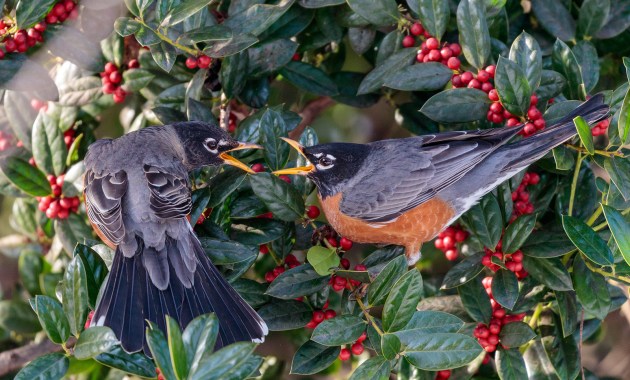
How do Robins Survive the Cold?
Robins are outfitted to survive huge temperature variances. In fact, hot weather seems to stress them more than cold.
If an American robin is healthy, has enough to eat, and is able to main its feathers, the temperature next to its body stays around 104 F—regardless of how cold it is in the world outside. It really is all about those feathers. (And the legs and feet.)
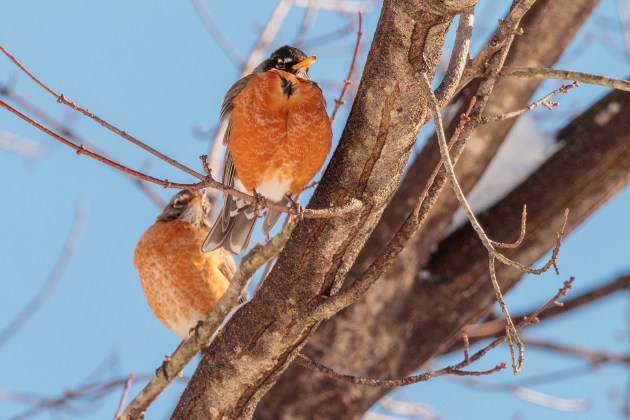
Robins, like most birds, have layers of feathers that perform different functions. When temperatures drop, robins puff the fine, downy feathers closest to their bodies to keep heat in, cold out. The outer feathers act like a kind of overcoat, shedding water and moisture and helping to regulate the bird’s temperature. (It’s an adaptation not limited to robins. Most birds with down feathers fluff them to regulate body heat).
The anatomy of a robin’s (and other bird species) also contributes to their cold adaptations. The bird experts over at the Cornell Lab explain it very well. The simplified version is that “most birds don’t succumb to frostbite because there is so little fluid in the cells of their feet, and their feet are mostly tendons and bones with little muscle or nerve tissue.”
So while blood does flow to their legs and feet, most birds (including robins) benefit from a very fast circulatory system and a “countercurrent heat exchange system.” Because bird legs are thin, the vessels that move blood from the heart to the feet and back again are very close together. That proximity means, per Cornell, “blood flowing back to the body is warmed by blood flowing to the feet. The newly cooled blood in the feet lowers heat loss from the feet, and the warmed blood flowing back into the body prevents the bird from becoming chilled.”
Robins: The Tell-Tale Birds of Spring
If robins are around in winter, why have they always been associated with the beginning of spring in the U.S.? Most likely it has to do with ground thaw, snow melt, and territorial behaviors like singing, worm hunting and nest building. But mostly, it’s the singing.
According to Journey North, which has a fantastic Q+A section I highly recommend for the robin-curious, “the robin’s song remains a reliable indicator that the first wave of spring migration has reached you. This song is one of the first signs that robins are switching from winter behavior to courtship and nesting behaviors associated with spring.”
Robins tend to move north as the ground thaws. The availability of high protein prey, especially worms that emerge with warmer, often wetter weather, is when a robin’s thoughts turn to procreation. And that’s the end of the cooperative fall and winter behaviors.
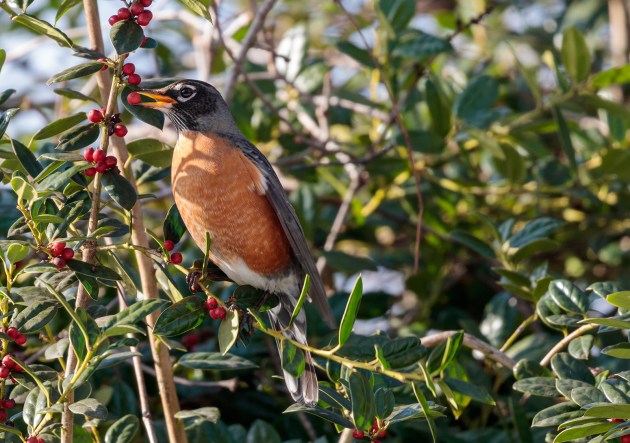
Which is one of the reasons many robins (primarily males) may stay through harsher winters instead of booking it to St. Petersburg: first access to the choicest nesting grounds. Breeding season is when robins also become more visible with mating displays, nest-building and a lot of time on the ground hunting for the tastiest worms. Until then, they’re all about the berries.
You Can Help Robins with Science from Your Own Backyard
Like many species, including other birds, scientists are starting to see some changes in robin behavior that is likely attributable to climate change. One study of American robins migrating to and from Canada’s boreal forest, showed that they’re beginning to journey south on average about 12 days earlier than in past years, or five days earlier per decade since 1994.
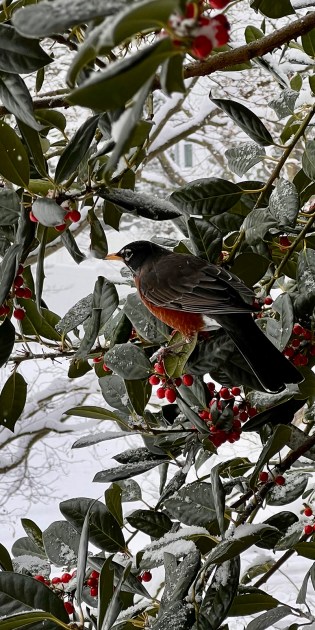
If you want to help scientists studying birds, there are several ways to contribute your observations (not just for robins, but for many of the species you can see outside your windows).
Journey North
You can submit your robin observations directly on the Journey North site (and check out their other migration-related citizen science projects). They also have 2025 maps tracking sightings so you can see where American robins (and other signs of spring) are being observed and follow along (and contribute to) the wanderings of Turdus migratorius.
Cornell Lab of Ornithology
The Cornell Lab has a number of different ways you can contribute to science for birds. Your sightings tracked on eBird (free) contribute to worldwide data for birding, science, and conservation. Want to know what birds are being seen in your neighborhood, eBird has a feature for that. If you’re new to birding, check out their genius birding ID app, Merlin.
You can also contribute to Project FeederWatch (requires subscription) by counting birds at your feeder from November through April. Your observations help scientists monitor changes in the abundance and distribution of birds, including the influence of changes in habitat, disease, and climate.
And mark your calendars for the 2025 Great Backyard Bird Count (February 14-17). Spend time in your favorite places watching birds—then report them to Cornell! It’s easy to participate, “in as little as 15 minutes notice the birds around you. Identify them, count them, and submit your counts to help scientists better understand and protect birds around the world. You can see the results from 2024 here.
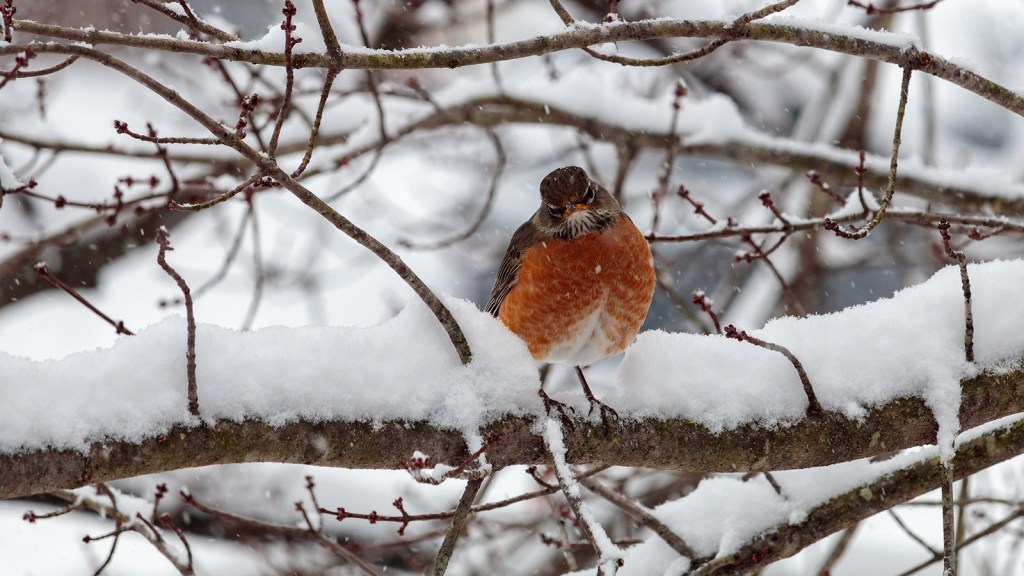



I thought Robins migrated in waves from North to South, that is the Robins we are now seeing locally are actually from further North. On my website I have several photos of Robins feeding in the snow:
https://onejackdaw.com/Robins_Thrushes_Mimics_Starlings/index.html
This is January 2nd 2018 on Orem Utah and I just saw a flock of about 20 robins in the yard. What is going on? They usually do not arrive until March or April.
I live in southwest Washington state. I have noticed large flocks of robins in the field and trees behind my house even in this late December, which surprised me. The beginning of your article was helpful in understanding this behavior. They do all look fat, which must be the fluffing of feathers you mentioned. This is my first winter in this house, so I don’t know if this is a regular occurrence, but I have lived in the general area for quite some time, and this is the first I’ve seen of this.
From Athol,ID
Oh my goodness what a surprise. Yesterday and today a flock of Robin have been visiting out trees.
We have no snow, it is chilly though.
What a gift.
Merry Christmas.
We travel north each spring from Fl to Pocono Mnts PA. I look forward to seeing the Robins. It is mud July and have only spotted one! Where have they gone? I miss thier chirp!
I have a robin’s nest near my front door so I’m getting a lot of great information about these guys! I have binacular’s too so I can get even closer.
It has been so neat watching them. I will try to be as brief as possible but there is SO much! From the beginning with the female building the nest so quickly. After a rainstorm she would bring mouthfuls of mud, grasses, twigs…she was WEAVING the twigs! every so often she would get inside and rock her body back and forth to mold the most perfect home.
After about 2 weeks the babies hatched on Mother’s Day! I saw what appeared to be the female “jack hammering” inside the nest. 3 days later I saw the tips of little beaks reaching up and both mother and father are continuously feeding them. (I don’t know how many, was afraid to peek in the nest and attract predators….believe it or not, crows watch and know somethings up)
So cute! The father is VERY gentle taking his time to feed, look, feed look….and the mother is quick and gets it done fast.
The father has made enough noise at times I run outside to find either a group of grackles or a crow too close to the nest. I scare them away. The male’s warning calls are about 30-40 ft away from the nest which is smart to not bring attention to where the nest is. The male doesn’t fly away. I’ve done this so much I believe they know that I’m helping them. I talk to her softly as I walk to my car (not looking or stopping) or bringing out the trash (about a foot from the nest) and neither fly away or make any sound.
Today has to be the coolest! We had torrential rains. I was so worried. Well, the mother stayed on the nest with her wing spread outside the nest! The rain ran off her to the ground instead of going into the nest. How smart! The male would fly in and appear to kiss the female. Out came the binacular’s. As the mom protected the babies, the father was bringing in food, transferring the food to the mother’s mouth! This went on the entire storm. Rain has subsided and both of them are muddy and drenched. Mom did all the actual feeding during this time that the father provided. I am in awe! I am keeping a close eye on them and hope the babies can survive the odds. Will keep you posted.
LOVE my Robin family!
Hi Kathy, That is so cool! I hope that you are sharing these observations on Journey North as well – observations like this are so valuable to improving our knowledge of robin behavior. Thank you for watching out for this robin family!
For two years in a row now, at this same time of year, I’ve driven past a local farm field (outside Montpelier, VT) while on my way home from work (around 6:15PM) and noticed that it was covered with robins, each about 10-15 feet away from any other robin. There were hundreds of robins in this network formation. Another field further down (separated from this one by woods and a few houses) was the same way. This spread along the road for about two miles. I have not read anything that approaches this. I believe the same field was slightly flooded last year. This year it is covered with about 3″ of slush and new snow/sleet accumulation, so it was not bare ground this year.
I’ve moved to a town that’s swamped in robins in the spring and started to notice their behaviours all the time due to the sheer numbers of them to watch. The behaviour that I’d like to understand is the “sit by oneself as fatly and grumpily-looking as possible on someone’s lawn, generally close to the road or sidewalk” behaviour. It looks territorial and possibly also the ground is warmer near the pavement, so potentially more food is available. But when I approach robins who are doing this in the park (rather than on lawns where they generally fly off), they tend to bob along just beside/ahead of me, dragging their wingtips but rarely flying off — yesterday, one robin possibly female was making a fuss on the top of a baseball diamond as the other bobbed along and when it eventually took off flew clumsily and not very effectively onto a shrub branch about a 2 feet off the ground. It’s too early for fledglings and these robins aren’t speckly and have very full red breasts anyhow. I just find it odd. Also, their grumpy faces are hilarious.
I’m in SE Michigan and we have one apple tree in our small condo subdivision that I pass every day. I’ve been waiting all winter to see robins in it and a few days ago I finally did! It was a small flock of about 8-10 and they were sharing the apples with a flock of cedar waxwings. I’ve seen flocks of these two species hang out in the winter before. They are fun to watch!
Just observed about 15-20 Robins in my Daughter-in-Laws yard. We live in St. Catharines, Ontario Canada just a few miles west of Niagara falls. This is the first time I have seen that many robins together this early in the year.
Robins have arrived at my house,Wichita,Ks and it’s only March.They sure have been enjoying my bird bath! Was wondering if you knew how to keep Crackels out of the suet I hang out? Got at least five that attack the cage! Now my woodpecker’s won’t come around.Thank you!
Hi Pam, Birds and Blooms has this article on how to keep “bully birds” like grackles away from your feeders: http://www.birdsandblooms.com/birding/birding-basics/bully-birds-feeders/
Wow this is a great article! We have always called the big fat cardinals we see in the winter CHARLES COUNTY MARYLAND cardinals and the smaller ones that arrive in spring migrating ones. Now I know they are just the same birds just not needing to keep warm so they “deflate” hahah. I live in a densely wooded area with loads of holly trees. Some taller than the house. The robins fill the trees in the early winter feasting on the berries. And then we don’t usually see large groups of them until we get a good snow, which isn’t every year.
Thank you for the lesson!
So happy to learn that Journey North is still around. I started using Journey North in my computer classes lab as soon as we had Internet connection in the 90s. We did many different projects for signs of spring. We did tulips, robins, and more. I retired in 1999. I hope many teachers are now involved because it is such a worthwhile opportunity for interaction with classes throughout the country and even the world, integrating many curriculum areas.
Several weeks ago, probably in January, we had Robins in our Robinson crab apple tree here in South Tamworth, NH between the Winnipesaukee Lakes Region and the Mount Washington Valley. I was quite surprised to see them, but they were eagerly eating the little apples during a heavy snow storm. It was a lovely surprise. Plenty of apples remain, but the Robins quickly moved on.